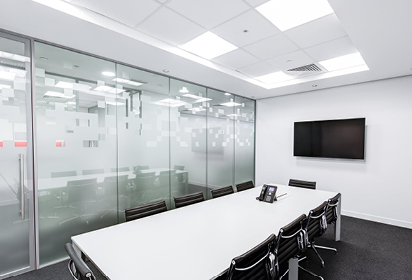When it comes to office design, lighting should be one of the biggest considerations – if not the biggest – because it has the potential to affect so many different aspects of working life. From improving employee health, wellbeing, and productivity, through to reducing energy consumption and maintenance costs, choosing the right lighting can have a significant impact on a business’s bottom line, not to mention the happiness of its workforce.
However, it’s not always as simple as just replacing one type of lighting for another; different areas of an office may require different lighting configurations depending on the type of work that happens in that workspace, and how often the lights are used, for example:
Office reception lighting
Office entrances or reception areas are where visitors – and potential customers or clients – get their first impression of a company, so it’s important to make it a good one. The lighting used in a reception will help set the tone for the entire office or building, and a key factor in creating that vital first impression made on any guests.
Using simple, minimalist light fittings will help create a highly corporate feel, whilst using bold colours and quirky lamp shades can help bring about a fun and laid back atmosphere. Lighting can also be used to highlight important areas within a business’s premises, such as the reception desk and walkways, in order to help guide visitors through the building.

The use of shape and colour creates a sense of fun in this example. Credit: officesnapshots.com
Office meeting room lighting
Flexibility is crucial when selecting lighting for meeting rooms, as these are typically rooms with multiple uses; from delivering presentations, through to more intimate one-on-ones, meeting rooms need lighting that flexes with employee’s needs. Having the ability to adjust the light levels through the use of dimmers or separate parts of the room using split lighting will allow whoever is using the meeting room to make sure the lighting is fit for their purpose.
Office floor lighting
The office floor is where the majority of staff spend most of their time, so making sure that the lighting is just right should be a high priority. The ideal lighting for office workspace is natural daylight, so lighting solutions that mimic and enhance natural light should be used where possible.
There are two crucial aspects to consider when choosing lighting for an office – background lighting and task lighting. Background lighting should be arranged to reduce overhead glare, which can be dazzling and lead to health issues such as headaches. To combat this, lighting should be evenly dispersed throughout the office space, whilst being careful to minimise shadows.
Task lighting should be adaptable so that employees can personalise light levels to fit their individual needs. It has been found that giving employees the ability to control their own lighting can decrease stress and boost job satisfaction. Adjustable desk lights give employees full control over their lighting ensuring that it can be tailored to suit their needs.
LED Lighting
We’ve previously highlighted why converting your office lighting to LEDs makes business sense. An LED installation can improve energy efficiency by up to 60% when compared to traditional fluorescent lights. There is also the equally important matter of longevity. LEDs have a lifespan of approximately 50,000 hours, far exceeding that of a regular bulb, further reducing maintenance time and costs. LEDs are the perfect option for lighting an office as they provide a brighter, clearer light in comparison to fluorescent tubes.
When designing the lighting for your office there are many different aspects to consider. If you are looking to upgrade the lighting in your office contact us today to see how we can help.

Charles Barnett Managing Director
Charles started Lyco in 1995 with just 4 enthusiastic employees and has grown it considerably over the past 25 years. Charles is also the Managing Director of Lighting Direct and newly acquired Online Lighting. He now has a team of 50 lighting experts working on growing Lyco Group to be the UK leader in lighting for both businesses and homes. Away from the office he is a keen cyclist and is proud to have cycled 1017 miles from Lands End to John O’Groats to raise money for a new residential centre for adults with multiple learning difficulties.









